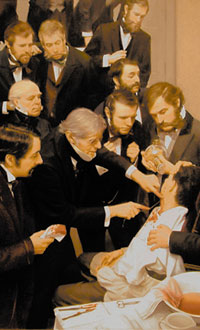WITH drugs, be they medicinal or recreational, it is often a matter of “shoot first and ask questions later”. One example of this approach is anaesthesia. It works, but no one really knows why. A team of researchers led by Nick Franks of Imperial College, London, has, however, recently posed that question, and may have got a little closer to answering it. You won't feel a thing
Modern anaesthetics seem to work by
mimicking deep sleep, rather than knocking people coldDr Franks and his colleagues set out to find exactly where the sedative effects of anaesthetics occur. That, they hope, will help to explain how such drugs work. They tested propofol, a member of a class of common modern drugs and compared it with ketamine, an older sedative now generally restricted to use in minor surgery. They found that although the two drugs both induce unconsciousness, they do so by acting on different parts of the brain. They presented their results at this week's meeting of the British Neuroscience Association, held in Harrogate.
Propofol is licensed for use in more than 50 countries. Most researchers in the field think it operates by making a neurotransmitter (a chemical messenger in the brain) called GABA work more effectively. GABA is an inhibitor. In other words, if a nerve cell is exposed to it, that cell becomes less active. Once a patient has propofol in his system, the effect of GABA is enhanced, causing a loss of short-term memory and, at sufficiently high doses, a loss of consciousness.
Ketamine, by contrast, acts on a neurotransmitter called glutamate, which is best known for its involvement in pain. Ketamine blocks the activity of glutamate by occupying the receptor molecules in the brain to which it would otherwise bind. That stops pain signals getting through. At sufficiently high doses, ketamine also causes unconsciousness.
Dr Franks and his colleagues took 166 adult male rats and divided them into two groups. The first group received propofol, the second ketamine. The researchers watched the rats to see that they passed out. Then they killed them so they could examine their brains.
They looked in particular for the presence of a protein called C-FOS. This protein is often produced when nerve cells are reacting to neurotransmitters and is thus regarded as a general marker for nerve-cell activity. They searched for it in three areas of the brain known to be associated with deep sleep.
With the rats given ketamine, the protein did not turn up in any great quantities in these areas. Studies by other researchers have suggested that ketamine works by suppressing activity in areas of the brain that are associated with emotions, which Dr Franks did not look at. In the case of the rats given propofol, however, Dr Franks and his team found C-FOS abundantly in an area called the tuberomammillary nucleus. This nucleus contains nerve cells that promote wakefulness. Only when people are in the motionless, dreamless period of deepest sleep do these cells normally rest. The researchers thus concluded that the tuberomammillary nucleus is crucial to the form of anaesthesia induced by propofol.
To test their results, they injected a similar anaesthetic directly into different parts of the brains of a handful of other rats. Only those that received the drug into the tuberomammillary nucleus passed out. They also examined the brains of mice that were genetically modified to be insensitive to propofol (no rats with this particular genetic modification were available). They found that the cells of the tuberomammillary nuclei of these mice were also insensitive, compared with those of normal mice.
Armed with the knowledge that one of the areas associated with deep sleep is also involved with the sort of anaesthesia caused by propofol, Dr Franks now hopes that it will be possible to design drugs that truly put people to sleep rather than knocking them out, in the way that ketamine does. Patients recovering from surgery may then emerge feeling pleasantly refreshed rather than having gone 12 rounds with Mike Tyson.
Refs
HOME
Propofol
Resources
Snapshots
Anaesthesia
Ketamine.com
